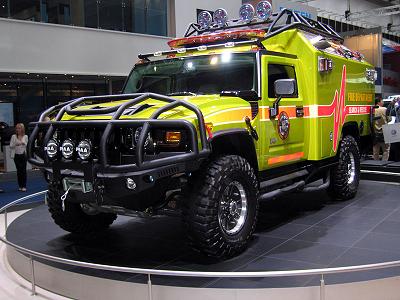Researchers have integrated into the cars a sophisticated sensing system capable of predicting accidents and activating the lateral protection system. Cameras and radar sensors scan the environment non-stop, and a central computer system analyzes the information. The system is able to differentiate between other cars and stationary objects and predict an approaching collision

I still fondly remember the Transformers animated TV series from my early childhood. The Transformers were giant robots that could shapeshift into cars, and back, and even protect their passenger. I always had the feeling that many engineers grew up on the dream of transformativeness - the ability to design vehicles that are able to change shape depending on the circumstances. That's why I was so happy to see that the dream is starting to come true within the framework of the European Union's APROSIS project, or Advanced Defense Systems.
During the project, Fernhofer company engineers, in collaboration with several universities, succeeded in developing a smart protection system that protects against damage to the side of the car and dramatically reduces the risk of injury to the passenger. The researchers integrated into the cars a sophisticated sensing system capable of predicting accidents and activating the lateral protection system. Cameras and radar sensors scan the environment non-stop, and a central computer system analyzes the information. The system is able to distinguish between other cars - which may be the source of an accident - and stationary objects such as houses or trees, and predict an approaching injury.
Despite the sophistication of the software, it is able to predict an impact on the side of the car only 200 thousandths of a second before the impact itself. But that's all it takes. As soon as the computer verifies the imminent impact, it releases an electric current that ignites a wire made of a smart alloy. The heat causes the wire to bend and release the spring attached to it. Inside the passenger seat is a steel beam, which the released spring pushes towards the door. At the same time, a metal plate inside the door is also released, until it rests against the steel beam. The researchers claim that the support provided by the metal plate against the steel beam stabilizes the car door and absorbs the impact energy.
Although the car cannot yet turn into a robot, throw the passenger into the air, avoid the impact and catch the passenger back before he falls to the ground. It also cannot violate the laws of conservation of mass and momentum, similar to the robotic heroes of our childhood. But considering the existing limitations, there is no doubt that the engineers and researchers of the European Union have advanced us one more step on the way to smarter and safer cars.
Source: http://www.fraunhofer.de/EN/press/pi/2008/03/ResearchNews32008Topic1.jsp

8 תגובות
I just now noticed the article (following Hugin's response) and I ask myself if it isn't a bit similar to the story about the big project the Americans did to develop a pen for astronauts that would work even in weightless conditions while the Russians just used a pencil.
The question arises as to why the door cannot be protected in the first place and why it needs such a sophisticated mechanism just to manage to protect it at the last moment (instead of, as mentioned, being protected in advance).
So it's true - there are problems here with the weight of the door and there are perhaps some other differences between mechanisms that are supposed to operate many times and a mechanism that is supposed to operate only once, but still it looks a bit funny.
And I, still a dreamer, a shaman, a genius, a genius and my heart, will open the fantasy version of: Of course,
Chat, chat, chat, bang, bang... great.. family and private.. to the point...
O good God, in heaven and on earth.. how many stars in the sky to count.. for the fulfillment of the wish??.
I love Transformers!
I don't think it's such an achievement
Maybe more suitable for skunks than robots...
Well… 🙂
The article just doesn't indicate if equipping the injured car with the technology does not increase the damage caused to the offending car.
It says that the metal plate 'absorbs' the impact. If it is not springy, it does not absorb the impact but 'returns' it.
Bye.
Well, almost.
transformers?